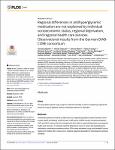Regional differences in antihyperglycemic medication are not explained by individual socioeconomic status, regional deprivation, and regional health care services. Observational results from the German DIAB-CORE consortium
Bächle, Christina
Claessen, Heiner
Maier, Werner
Tamayo, Teresa
Schunk, Michaela
Rückert-Eheberg, Ina-Maria
Holle, Rolf
Meisinger, Christa
Moebus, Susanne
Jöckel, Karl-Heinz
Schipf, Sabine
Völzke, Henry
Hartwig, Saskia
Kluttig, Alexander
Kroll, Lars Eric
Linnenkamp, Ute
Icks, Andrea
Aims: This population-based study sought to extend knowledge on factors explaining regional differences in type 2 diabetes mellitus medication patterns in Germany. Methods: Individual baseline and follow-up data from four regional population-based German cohort studies (SHIP [northeast], CARLA [east], HNR [west], KORA [south]) conducted between 1997 and 2010 were pooled and merged with both data on regional deprivation and regional health care services. To analyze regional differences in any or newer anti-hyperglycemic medication, medication prevalence ratios (PRs) were estimated using multivariable Poisson regression models with a robust error variance adjusted gradually for individual and regional variables. Results: The study population consisted of 1,437 people aged 45 to 74 years at baseline, (corresponding to 49 to 83 years at follow-up) with self-reported type 2 diabetes. The prevalence of receiving any anti-hyperglycemic medication was 16% higher in KORA (PR 1.16 [1.08–1.25]), 10% higher in CARLA (1.10 [1.01–1.18]), and 7% higher in SHIP (PR 1.07 [1.00–1.15]) than in HNR. The prevalence of receiving newer anti-hyperglycemic medication was 49% higher in KORA (1.49 [1.09–2.05]), 41% higher in CARLA (1.41 [1.02–1.96]) and 1% higher in SHIP (1.01 [0.72–1.41]) than in HNR, respectively. After gradual adjustment for individual variables, regional deprivation and health care services, the effects only changed slightly. Conclusions: Neither comprehensive individual factors including socioeconomic status nor regional deprivation or indicators of regional health care services were able to sufficiently explain regional differences in anti-hyperglycemic treatment in Germany. To understand the underlying causes, further research is needed.
Dateien zu dieser Publikation
Keine Lizenzangabe

